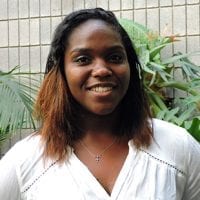
Elucidating genetic variation in ‘Candidatus Liberibacter asiaticus’ transmission between Asian citrus psyllid isofemale lines
Project Summary
Citrus greening disease or Huanglongbing (HLB) is the most devastating citrus disease worldwide. HLB causes citrus to be inconsumable due to a reduction in fruit quality, decrease in overall fruit production and eventual death of the citrus tree. The disease is associated with this bacterium Candidatus Liberibacter asiaticus (CLas), which infects citrus hosts by being acquired and transmitted by the Asian citrus psyllid (ACP). CLas must infect the ACP by traveling through its saliva, gut wall, blood and return to the saliva to be successfully transmitted. It has been found that the rate acquisition and transmission rates of CLas are variable. Much of the work in citrus greening is focused on the development of improved early detection methods for the disease by understanding both of these factors. My project focuses on improving the current psyllid genome through manual curation, as well as helping characterize transmission rates among different ACP isofemale line via quantitative Polymerase Chain Reaction (qPCR). Gene families that are involved in psyllid immunity have been identified and are curated with the objective of understanding how they contribute to CLas infection of the psyllid. While, qPCR allows us to quantify the amount of CLas present in citrus leaves post ACP feeding, we can then analyze the transmission rates. The ability to connect transmission rates with different psyllid lines may allow for further experiments to reveal the connection between phenotypic and genotypic variation that lends to the spread of CLas. Objectively, our goal is to slow the disease spread and stop losses in the citrus industry.
My Experience
My summer at the Boyce Thompson Institute and Cornell University was wonderful. I had the opportunity to explore another scientific method by gaining computational skills in the field of bioinformatics. Before this summer I was not attune to the connections between molecular biology techniques and bioinformatics, such as how protein expression analysis may contribute to the structural change of a gene model. I am immensely grateful for the caring and open community that I experienced while interning at BTI. Working individually with my mentors and collaboratively with members of the Cilia and Mueller lab I felt supported and capable of success while working toward our goal. My overall experience was equally challenging and rewarding. Additionally, I was privy to various perspectives about the different paths I can pursue as I continue on in the field of scientific research and eventually toward my Ph.D.
